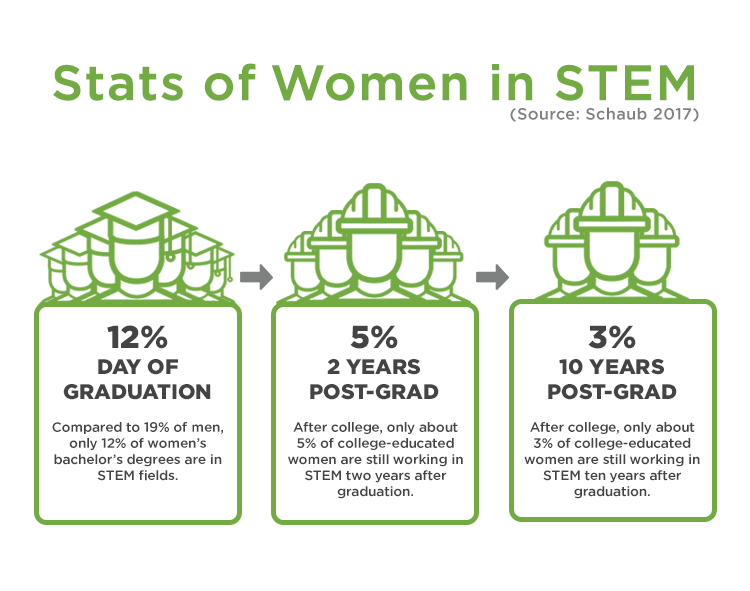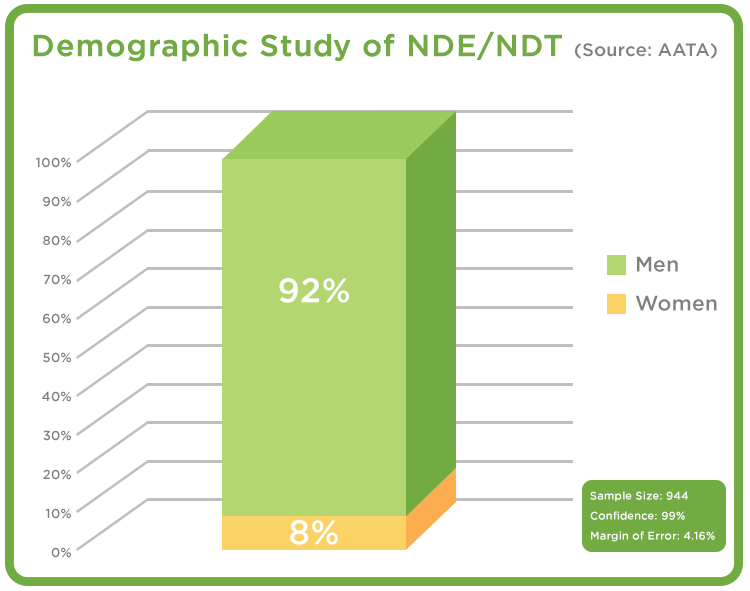As March comes to a close, we reflect on the trailblazing women who led the way to change by celebrating Women’s History Month and the theme of “Choose to Challenge.” Women around the world struck the #ChooseToChallenge pose showing their commitment to challenging inequality, calling out bias, questioning stereotypes, and helping forge an inclusive world.
In the Nondestructive Evaluation and Testing (NDE/NDT), as well as the tech industry, we recognize both the growth of women in the fields, yet also their paucity. Over the past five decades, women in the United States have made strides in achieving equal representation in education and the workplace. With 48 percent of the workforce now represented by women, they are still less present within STEM sectors - science, technology, engineering, and mathematics. The Numbers for Women in STEM
The Numbers for Women in STEM
Compared to 19 percent of men, only 12 percent of women’s bachelor’s degrees are in STEM fields. After college, only 5 percent of college-educated women are still working in STEM two years after graduation, and only 3 percent after 10 years (Schaub 2017). Referred to as the “leaky pipeline,” this phenomenon suggests that women “leak” through various cracks along the professional development path from education to advanced careers.
The “leaky pipeline” metaphor continues to be an issue at each stage of the corporate hierarchy, with odds stacked particularly against women of color.

Representation in NDE/NDT
In industries like NDE/NDT, where leaky pipelines occur, technician and inspector roles have been largely male-dominated. In an AATA Demographics Study, 944 NDE/NDT professionals, in a data-set that included 30 companies in the United States, at levels I, II, and III, were surveyed for age, sex, veteran levels, and race. Of the 944 who participated, a mere 8% were female; a total of 75 women in the group overall. With an estimated 50K total NDT Technicians in the population, this brings the female representation to an estimated 4,000 compared to 46,000 males.
The NDE 4.0 Revolution
Defined as the “cyber-physical nondestructive evaluation and testing” NDE 4.0 is arising out of a confluence of Industry 4.0 digital technologies, physical inspection methods, and business models; to enhance inspection performance, integrity engineering, and division making for safety, sustainability, and quality assurance, as well as provide relevant data to improve design, production, and maintenance” (Vrana and Singh 2021). NDE 4.0 anticipates using various sensory systems and providing numerous opportunities for robotics and automation; augmented reality (AR), artificial intelligence (AI), Internet of Things (IoT), big data, digital image and signal processing, computer vision, and additive manufacturing (AM) are among these opportunities.
NDE 4.0, being called the next revolution, relies heavily on determining the safety of an asset to its consumers and users, while ensuring that inspectors are also kept safe. Economic drivers are demanding operational capacity and effective inspections, therefore, expecting Industry 4.0 to use the four design principles that have been interpreted for NDE applications; inclusive of interoperability, information transparency, technical assistance, and decentralized decisions.
But who is expected to lead the NDE 4.0 revolution at hand?
Collaboration for Technology Integration
According to Barbara Trautlein, author of Change Intelligence, 70% of changes fail. However, the awareness of one’s own Change Leader Style, or Change Intelligence (CQ), has the ability to adapt and be optimally effective in leading change across a variety of people and situations.
Leaders often lead with either Heart, Head, or Hands. Those who lead mainly from the heart tend to connect with people on an emotional level; leading from the head are connecting with people cognitively; leading from the hands are connecting with people behaviorally. Research by Trautlein indicates that men tend to lead change more with the head, while women lead with the heart; with hands being a strong secondary style of leadership. Women are centering around supporting their teams to work together and develop detailed road maps to achieve change, and often function more like supportive coaches, while men traditionally associate with strategic executives and primarily focus on future vision and new business horizons.
The research by Trautlein shows that women are more than well-suited for leadership roles through the new revolution; these female leaders shouldn’t suppress their abilities to fit in a male-dominated field, rather use these gifts to transform the culture thereby contributing to innovation and overall success.
With Industry 4.0, collaboration is key in technology integration, and changing the dynamics will require leading by heart and hands; indicating that women will have an edge in leading through digital transformation in this era of the innovator.

Conclusion: Preparation for the New Revolution
Ensuring the safety of infrastructure, assets, and inspectors is a serious challenge; the models emerging from NDE 4.0 will present new opportunities for change for the better. To fully realize the benefits, the industry must harness the talents of traditionally underrepresented groups that have learned the importance of resilience in their careers.
This starts with getting more women into STEM and NDE/NDT, starting at the childhood level, as innovation seeks energy, optimism, and diversity. Supporting these women from pre-school through college and to the workplace will counteract the “leaky pipeline.” Adopting Programs and mentorship that take full advantage of the skill sets in a talent pool, in a gender-neutral manner, will lead to companies enacting change in company policies on gender diversity, job retraining, and intentional innovation groups.
Most importantly, a company culture that invites women leaders to participate equally in NDE 4.0 will reap the benefits of a fuller approach to collaboration, unleashing the unique qualities of both genders in the workplace.
In honor of Women’s History Month, we’ve highlighted several female employees on our social channels. Each woman has shared their professional journey, the most rewarding aspects of their job and provided advice to young women pursuing similar careers. Visit our LinkedIn page to hear their stories.
